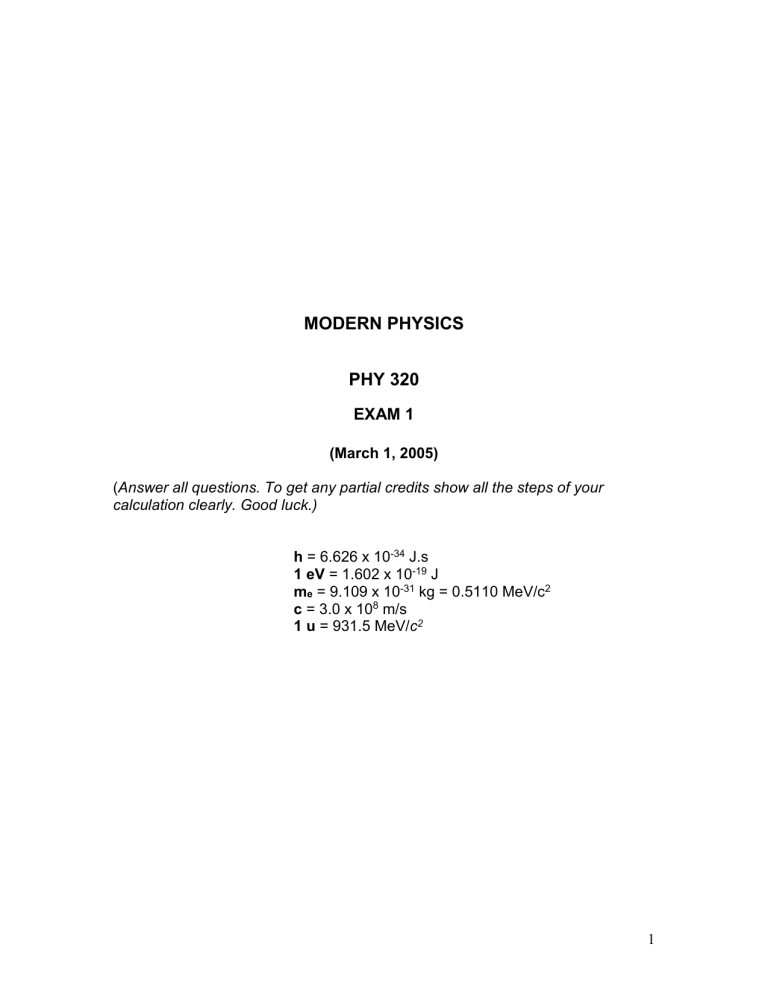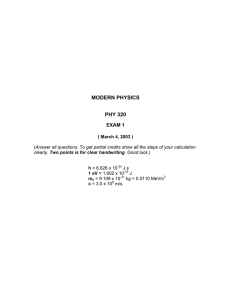MODERN PHYSICS PHY 320 EXAM 1

MODERN PHYSICS
PHY 320
EXAM 1
(March 1, 2005)
( Answer all questions. To get any partial credits show all the steps of your calculation clearly. Good luck.) h = 6.626 x 10 -34 J.s
1 eV = 1.602 x 10 -19 J m e
= 9.109 x 10 -31 kg = 0.5110 MeV/c 2 c = 3.0 x 10 8 m/s
1 u = 931.5 MeV/ c 2
1
1. Briefly and clearly answer the following questions: (5 x 4 = 20 pts)
(a) What are the postulates of special theory of relativity?
(b)
A frame S’ is moving with a constant velocity v along the y-direction with respect to the frame S. What are the coordinates (x’,y’,z’,t’) of S’ in terms of the S-frame coordinates (x,y,z,t)? Also write the inverse coordinate transformation equations.
(c) A spaceship in the shape of a sphere moves past an observer on Earth with a speed of 0.5c. What shape will the observer see as the spaceship moves past?
(d) What happens to the density of an object as its speed increases, as measured by an Earth observer?
2
Problems: (Make sure to show all the steps clearly)
2. Consider a box at rest with sides a, b, and c. Its rest (proper) mass is m
0
, and its rest mass per unit volume is
0
= m
0
/abc. (a) What is the volume of the box as viewed by an observer moving relative to the box as viewed by an observer moving relative to the box with speed u in the x direction? (b) What is the density of the box, in terms of
0
, as measured by this observer?
(15 pts.)
Sol:
3. Calculate for the judge, how fast you were going in miles per hour when you ran the red light because it appeared Doppler-shifted green to you. Take red light to have a wavelength of 650 nm and green to have a wavelength of
550 nm. (10 pts.)
Sol:
3
4. The pion has an average lifetime of 26.0 ns when at rest. For it to travel
10.0 m, how fast must it move? (10 pts.)
Sol:
5. An object disintegrates into two fragments. One of the fragments has mass
1.00 MeV/ c 2 and momentum 1.75 MeV/ c in the positive x direction. The other fragment has mass 1.50 MeV/ c 2 and momentum 2.005 MeV/ c in the positive y direction. Find (a) the mass and (b) the speed of the original object. (20 pts.)
Sol:
4
6. The nucleus C 12 consists of six protons (H 1 ) and six neutrons ( n ) held in close association by strong nuclear forces. The rest masses are
C 12 12.000000 u
H 1 1.007825 u n 1.008665 u
How much energy would be required to separate a C 12 nucleus into its constituent protons and neutrons? This energy is called the binding energy of the C 12 nucleus. (15 pts.)
Sol:
7. A positron and an electron at rest in frame S combine and annihilate one another, producing two photons. (a) What is the energy and momentum of each photon in this frame? What quantities are conserved in this process? (b)
Prove that the positron and electron cannot combine to produce only one photon. (10 pts.)
Sol:
5




